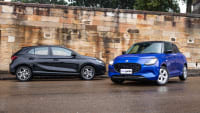A vehicle’s ability to tow a trailer has always been a major selling point in the Australian car market, but that function has developed even more appeal in recent times as time-poor people seek to make the most of their leisure time.
Whether it is a trailer with a car on-board, or a boat or a horse trailer, or a caravan, or camper-trailer, a vehicle’s ability to cop that load and do so without sacrificing ride and handling, comfort, stability, safety and acceptable fuel consumption are crucial aspects of its general appeal to buyers.
To be regarded as a great tow vehicle, the car in question must perform well under duress (i.e. with a load on-board, trailer or otherwise); it must maintain its optimum ride and handling while towing a trailer, laden or unladen; it must remain safe while towing a load; it must be comfortable, roomy, and able to cope with plenty of gear inside and out.
Generally, diesel-engined cars make better towing vehicles than petrol-powered models because they produce more torque in a low-to-medium rev range and are more fuel efficient.
To best gauge overall towing prowess, we consider a vehicle’s ability to tow in a range of circumstances and terrain – urban/city driving, at highway speeds, along bush back-roads and gravel tracks with varying loads on trailers but within the vehicle’s legal towing limits – because that is indicative of real-life applications.
Some people want a heavy hauler (maximum braked towing capacity of 3500kg and up) and others only need to tow smaller loads (up to 2000kg). In today’s market there is something for everyone, no matter what you plan to tow.
Don’t be overwhelmed by a vehicle manufacturer's weight-related figures; always keep in mind a vehicle’s real-world capabilities.
Your vehicle’s towing capacity (unbraked and braked) will be detailed in the owner’s manual. For example, a MY17 Ford Ranger will have a claimed towing capacity of 750kg (unbraked), and 3500kg (braked).
According to RACQ: “A vehicle's towing capacity is determined by its manufacturer and is based on factors such as the design of the vehicle, the vehicle's rear axle load, the capacity of its tyres and the effect the laden trailer will have on the vehicle's attitude, stability, durability and overall safety.”
Don’t be overwhelmed by a vehicle manufacturer's weight-related figures; always keep in mind a vehicle’s real-world capabilities, including its GCM (Gross Combined Mass), GVM (Gross Vehicle Mass) and braked tow rating, and remember to factor into your equation the fact that your vehicle will be fully loaded with driver, passengers, camping gear and more when you’re on an actual trip.
Tip: use your local weigh bridge and always err on the side of caution, i.e. don't load up so you're anywhere near the manufacturer's listed towing capacity limit – if it's a maximum towing capacity of 2000kg, load up 1800kg. If you plan on towing regularly, before you tackle any trailers or such, if available, add the carmaker's load-assist pack to your load-hauling arsenal.
(For a detailed explanation of vehicle- and towing-weight-related terms, go to Mark Oastler’s superb yarn on the expansive subject.)
When you ask yourself – Can my car tow a trailer? – make sure you’ve done exhaustive research in order to respond with confidence. What exactly is the best car for towing a trailer, or the best 4x4 for towing a trailer, or the best SUV for towing a trailer? You’ve got your tow kit ready – towball, tow bar and more – so now you’re ready to peruse our top picks for tow vehicles.
Full-size 4X4
1. RAM Laramie 2500
.jpg)
This is a late inclusion because I've just received a pay-rise and can now afford one of these (I wish). For gargantuan towing ability the Ram Laramie 2500 ($139,500 plus on-road costs) takes the towing cake.
The 3577kg Ram Laramie 2500 4X4 – 6027mm long, 2009mm wide, 1974mm high, and with a 3797mm-long wheelbase – has a maximum towing capacity of 6942kg (braked). Yep, you read that right.
This towing behemoth gets its strength from a 6.7-litre six cylinder Cummins turbo-diesel engine (276kW/1084Nm!), backed by an intelligent six-speed auto trans, a 4x4 drivetrain designed to tackle heavy-duty towing and a monster-stopping exhaust brake.
Its tray has a spray-on liner and is 1939mm long (on the floor), 1687mm wide (1295mm between wheel arches) and 511mm deep.
The Ram Laramie has not been ANCAP tested but it has passed the ADR crash test. It has a three-year/100,000km warranty with service intervals of 12 months/12,000km.
Fuel consumption figures are unavailable but CarsGuide senior journalists have recorded about 20.0L/100km (with heavy towing) and 15.0L/100km (mixed driving, no towing). It has a 117-litre fuel tank.
Its stablemate – the RAM 3500 – is also worth a mention, though you need to throw your money down on the $143,900 version, which you can legally drive on a regular car licence. It has a maximum towing capacity (braked) of 6171kg.
2. Toyota LandCruiser 200 Series GXL (4X4)

It cruises comfortably over long distances and powers up long hills, no matter the load. Factor in its coil-spring suspension set-up and safe, stable and stress-free towing is virtually guaranteed.
It has a smooth six-speed auto matched to an engine – a 4.5-litre twin turbo-diesel V8 – that produces 200kW@3600rpm but, more importantly, a tree stump-dragging 650Nm@1600rpm.
Fuel consumption is a claimed 9.5L/100km (combined), without a trailer. It has a 93-litre main tank and a 45-litre auxiliary tank.
The 200 Series has a five-star ANCAP rating.
3. Y62 Nissan Patrol TI 4X4

This petrol-only behemoth – 2700kg, 5165mm long (with a 3075mm-long wheelbase), 1995mm wide (excluding mirrors) and 1940mm high – comes from a long line of good towing Nissans.
Heritage is strong in the Y62 and a 5.6-litre V8 – yielding 298kW@5800rpm and 560Nm@4000rpm – and a seven-speed auto doesn't hurt its towing cause a bit either.
This base-spec eight-seater Patrol (from $69,990, excluding on-road costs) is rated to tow 3500kg (braked), has a GVM of 3500kg and a whopping GCM of 7000kg.
Fuel consumption is a claimed 14.4L/100km (combined), sans load. Obviously, that figure will increase with towing, but the same will happen in one of its diesel competitors. It has a touring-friendly 140-litre fuel tank.
It has a five-star ANCAP rating.
4. Land Rover Discovery HSE 4X4

This Discovery (2298kg, 4970mm long with a 2923mm-long wheelbase) is rated to tow 3500kg (braked), has a GVM of 3170kg (in the seven-seater version) and a GCM of 6670kg.
It is the fifth generation of this popular model and is offered with a choice of three engines (four-cylinder or V6), four trim levels and five or seven seats. The upper-spec seven-seater HSE (from $87,150 excluding on-road costs), with the punchy 3.0-litre Td6 (190kW@3750rpm and 600Nm@1750-2250rpm) and eight-speed auto, is well-suited to towing duties. Coil-spring and air suspension make for a well-settled driving experience.
Fuel consumption is a claimed 7.2L/100km (combined). It has an 85-litre fuel tank.
It has a five-star ANCAP rating.
Large SUVs
1. Isuzu MU-X LS-T 4X4

This MU-X (2157kg, 4825mm long with a 2845mm-long wheelbase) is rated to tow 3000kg (braked), has a GVM of 2750kg and a GCM of 5750kg.
It may not have world-record towing, GVM or GCM figures (head to Comments to have a whinge), but it belongs here because it has a no-fuss, reliable approach to everything.
There are three trim levels in the seven-seater MU-X line-up but we'd opt for the top-spec LS-T 4X4 (from $56,100, excluding on-road costs). All models have the new, as of 2017, Euro5 emissions-compliant 3.0-litre four-cylinder turbo-diesel engine. That donk, especially built for Australia, produces 130kW@3600rpm (same as before) but now yields 430Nm@2000-2200rpm – which is 50Nm more than its predecessor.
The LS-T is available only with the new, as of 2017 also, six-speed Aisin-produced auto. The new engine and transmission are a hardy, dependable truck-like combination.
Fuel consumption is a claimed 7.9L/100km (combined). It has an 65-litre fuel tank.
It has a five-star ANCAP rating.
2. Hyundai Santa Fe Highlander

This Santa Fe is a solid tow vehicle with a gutsy engine. The auto-only Highlander has a GVM of 2600kg, GCM of 4600kg, and a towing capacity of 2000kg (braked), 750kg (unbraked). Maximum towball weight is 150kg with a genuine Hyundai load-assist kit.
The seven-seater AWD Santa Fe is one of the few SUVs that manages to pack a lot of gear into a neat, nice-looking package and is also supremely capable at everything it is claimed to be good at, even towing.
The upper-spec Highlander ($57,090, plus on-road costs) has a 2.2-litre common-rail direct-injection (CRDi) engine (147kW@3800rpm and 440Nm@1750-2750rpm), mated to a six-speed automatic transmission. It is 4700mm long with a 2700mm wheelbase and has a kerb weight of 1857kg.
Claimed fuel consumption is 7.8L/100km (combined).
It has a five-star ANCAP rating.
3. Mazda CX-9 GT

The GT's GVM is 2575kg (AWD; 2505kg for the FWD version). It has a towing capacity of 2000kg (braked), 750kg (unbraked), and a towball download limit listed as 100kg.
Mazda's petrol engines perform so well and are so fuel efficient that it doesn't even bother making a diesel CX-9 option. No matter, because this big seven-seater wagon ($61,390, plus on-road costs in GT AWD spec), big, long and low, is a real goer when it comes to towing missions.
It has a turbocharged 2.5-litre four-cylinder petrol engine (170kW@5000rpm and 420Nm@2000rpm), mated to a six-speed automatic transmission. It is 5075mm long with a 2930mm wheelbase and has a kerb weight of 1974kg.
This CX-9 is a great family all-rounder.
Claimed fuel consumption is 8.8L/100km (combined).
It has a five-star ANCAP rating.
Utes
1. LandCruiser 70 Series Double Cab Chassis GXL

This tall, boxy unit – 2175kg, 3180mm-long wheelbase, 1870mm wide and 1955mm high – looks the business. Bonus: it is, and can tow like a champion; it has a maximum capacity of 750kg (unbraked) and 3500kg (braked).
But those cold-hard figures don’t indicate just how well this thing carts a trailer, safely and securely, without a fuss. When it comes to trailer towing – whether it's a car towing trailer or a horse trailer – the LC70 is the bee's knees.
For the figure conscious, the 70’s GVM is 3300kg and its GCM is 6800kg.
Sure, this ute only has a three-star ANCAP rating (out of a maximum five) and has few creature comforts (air con is a $2761 option), but with a grunty 4.5-litre V8 turbo-diesel engine (151kW/430Nm), five-speed manual gearbox and 130-litre tank, it's ready to tow stuff wherever you have to go.
Pricing is high ($68,990 for the GXL) but this thing is worth it.
2. Ford Ranger XLT dual-cab 4x4

The XLT – 2200kg, 5426mm long (with a 3220mm wheelbase), 2163mm wide and 1821mm high – can tow up to 750kg (unbraked) and 3500kg (braked). Its GVM is 3200kg; its GCM is 6000kg.
This Ranger ($57,600 plus on-roads) has a 3.2-litre five-cylinder turbo-diesel engine (147kW/470Nm) and a six-speed auto.
Fuel consumption is a claimed 9.0L/100km, and it has an 80-litre fuel tank.
The tray is 1549mm long, 1139mm wide (between the wheelarches), 511mm deep and has four tie-down points. Load height (floor height to ground) is 840mm.
The Ranger has a five-star ANCAP rating.
3. Mazda BT-50 XTR Dual Cab

A great blend of passenger-car comfort and real-world practicality, the second-best spec XTR ($50,890 plus on-road costs) is rated to tow 3500kg (maximum, braked). GVM is 3200kg; GCM is 6000kg.
It has a kerb weight of 2105kg and is 5365mm long (with a 3220mm wheelbase), 1850mm wide and 1815mm high.
It has a 3.2-litre five-cylinder turbo-diesel engine (147kW/470Nm), mated to a six-speed auto.
Fuel consumption is a claimed 9.7L/100km, and it has an 80-litre fuel tank.
The tray is 1549mm long, 1560mm wide (1139mm between the wheel-arches), 513mm deep and has six 'interior rope hooks'. Load height is 841mm.
The BT-50 has a five-star ANCAP rating.
4. Isuzu D-Max LS-T

The D-Max has a maximum braked towing capacity of 3500kg and 750kg unbraked. GVM is 2950kg; GCM is 5950kg.
It's 5300mm long (with a 3095mm wheelbase), 1900mm wide (excluding wing mirrors), and 1850mm high (excluding roof rails). Kerb weight is listed as 2026kg.
This Isuzu (from $54,200 in this guise) is feature-packed and highly functional. It's also a ute, through and through, and proudly so, and it is supremely practical.
The recently updated D-Max now comes with a new six-speed auto or manual and new engine (Euro 5 compliant 3.0-litre four-cylinder turbo-diesel, 130kW/430Nm).
Fuel consumption is a claimed 7.9L/100km, and it has a 76-litre fuel tank.
The D-Max's tray is 1552mm long (on the floor), 465mm deep and 1530mm wide across the top, and 1105mm wide, between wheelarches. The tray has four tie-down points, one at each corner. Load height is 800mm.
The D-Max has a five-star ANCAP rating.
Smaller SUVs
1. Mitsubishi Outlander LS Di-D

This seven-seater Outlander ($39,500 plus on-road costs) weighs 1630kg and has a maximum towing capacity of 2000kg. It has a GVM of 2280kg and a GCM of 4280kg.
It has a 2.2L TD engine (110kW/360Nm) and a six-speed torque-converter auto.
The Outlander is 4695mm long, 1810mm wide and 1710mm high.
This Mitsu is not as sporty or as lively as some of its rivals, but has more than enough grunt to tow well – that 360Nm is nudged and maintained from 1500rpm to 2750rpm – and it does everything in an efficient manner.
Fuel consumption is a claimed 6.2L/100km, and it has a 60-litre fuel tank.
The Outlander has a five-star ANCAP rating.
2. Hyundai Tucson Elite

The Tucson Elite ($41,750 plus on-road costs) weighs 1650kg and has a maximum towing capacity of 1600kg, a figure on the low side compared to other compact towing vehicles, but you shouldn’t be towing anything bigger in a vehicle this size any way. The Tucson is 4475mm long, 1850mm wide and 1650mm high.
The mid-size SUV has a 2.0-litre turbo-diesel engine (136kW/400Nm) with a six-speed auto; and that 400Nm is a real plus when it comes to towing ability.
Fuel consumption is a claimed 6.4L/100km, and it has a 62-litre fuel tank.
The Tucson Elite has a five-star ANCAP rating.
3. Suzuki Grand Vitara Sport

The five-seat Grand Vitara ($30,990 plus on-road costs) weighs 1620kg and has a maximum towing capacity of 1700kg (braked) and 750kg (unbraked). That max capacity stretches to 2000kg or more if you have a V6 Sport.
Sure, this Suzuki is not long for the Australian market, but if you can find a new example or even shopping used, it has rock-solid history of being a sure and steady lightweight towing machine.
In the load-hauling realm where diesel engines tend to dominate in the popularity stakes over petrol ones, this Grand Vitara persists with a 2.4-litre petrol and a four-speed auto (122kW/225Nm) and dual-range transmission.
The Sport is 4500mm long (with a 2640mm wheelbase), 1810mm wide and 1695mm high.
It has a GVM of 2100kg; a GCM figure was unavailable.
This Suzuki’s 2.4-litre engine is a gutsy unit, yielding a nice spread of torque from early on, very handy for towing.
Fuel consumption is a claimed 9.9L/100km, and it has a 66-litre fuel tank.
The Grand Vitara Sport has a four-star ANCAP rating.

.jpg)
.jpg)


.jpg)


.jpg)
.jpg)
.jpg)

_0.jpg)



.jpg)

.jpg)
.jpg)